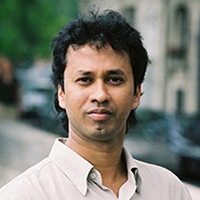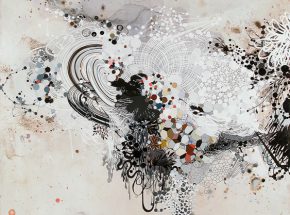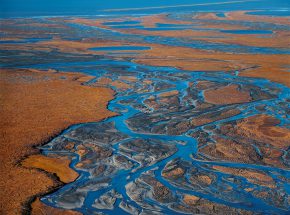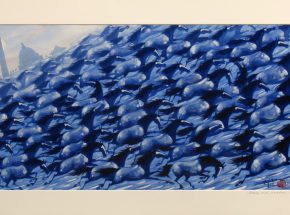

Subhankar Banerjee is an Indian born American photographer, writer, environmental educator, and activist. Through his ongoing project LAND AS HOME he works to raise awareness about issues that threaten the health and well-being of our planet. Over the past decade he has been a leading international voice on issues of arctic conservation, indigenous human rights, resource development, and climate change. More recently he has also been focusing on global forest deaths from climate change. His photographs, writing, and lectures have reached tens of millions of people around the world. On August 26, 2010 Subhankar founded CLIMATESTORYTELLERS.ORG and became a regular contributor to THE HUFFINGTON POST.
Subhankar was born in 1967 in Berhampore, a small town near Kolkata, India. His early experiences in his parents’ tropical home in rural Bengal fostered his life long interest in the value of land and it’s resources. Early in his childhood his parents introduced him to the work of their friend – renowned writer and activist MAHASWETA DEVI, whose work and life continues to inspire him immensely. During his childhood, in the cinemas of the small towns where he grew up, he also came to know the work of brilliant Bengali filmmakers including, SATYAJIT RAY, MRINAL SEN, and RITWIK GHATAK. He loved cinema and found their visual explorations of everyday life and larger social issues immensely inspiring. His great uncle Bimal Mookerjee, a painter, taught him how to paint. He created portraits and detailed rural scenes, but knew from growing up in a middle-income family that it would be nearly impossible for him to pursue a career in the arts. He chose instead the practical path of studying engineering in India and later earned two masters degrees in physics and computer science at New Mexico State University in the US.
In the New Mexican Desert, he fell in love with the open spaces of the American West. He hiked and backpacked frequently in New Mexico, Arizona, Colorado, and Utah, and bought a 35mm camera with which he began taking photographs. After finishing his graduate study, he moved to Seattle, Washington to take up a research job in the sciences. In the Pacific Northwest, his commitment to photography grew, and he photographed extensively during many outdoor trips in Washington, Oregon, Montana, Wyoming, California, New Hampshire, Vermont, Florida, British Columbia, Alberta, and Manitoba. In 2000, he left his scientific career behind and began a large-scale photography project in the American Arctic.
After a fourteen-month long journey in the Arctic National Wildlife Refuge, Subhankar published his first book in 2003, ARCTIC NATIONAL WILDLIFE REFUGE: SEASONS OF LIFE AND LAND. Through a generous grant from Lannan Foundation, 10,000 copies of the book were donated to libraries, students, and policy makers in the United States and other Arctic countries. The accompanying exhibition at the Smithsonian National Museum of Natural History was censored during the Bush administration, that resulted in major international press and media coverage of his work. Subsequently the California Academy of Sciences revived the exhibition and traveled it around the US. A detailed account of that history can be found in historian Finis Dunaway’s essay Reframing the Last Frontier: Subhankar Banerjee and the Visual Politics of the Arctic National Wildlife Refuge that appeared in the anthology A KEENER PERCEPTION: ECOCRITICAL STUDIES IN AMERICAN ART HISTORY.
Subhankar’s work has been instrumental in the conservation efforts of the ecologically and culturally significant areas of the American Arctic, including, Arctic National Wildlife Refuge, Teshekpuk Lake wetlands, Utukok River uplands, Beaufort and Chukchi seas. He works closely with the Gwich’in and Inupiat indigenous communities of Alaska and the Canadian Yukon. He also spent time with the Yukaghir and the Even indigenous communities in Siberia.
His photographs have been exhibited in more than fifty museums and galleries in the US and Europe. Recent and forthcoming solo exhibitions venues include, Hood Museum of Art at Dartmouth College (2007), Hopkins Center for Arts at Dartmouth College (2009), School of Fine Arts Gallery at Indiana University (2010), and Amon Carter Museum in Fort Worth (2011). His photographs have been published in over two-hundred magazines and newspapers internationally, including two collaborations with writer Peter Matthiessen for The New York Review of Books (2007 | 2006), and two articles in Vanity Fair (2008 | 2003 PROFILE BY INGRID SISCHY).
His writings have appeared in TOMDISPATCH – a project of The Nation Institute (2010), in THE ALASKA NATIVE READER: HISTORY, CULTURE, POLITICS published by Duke University Press (2009), in THE SCHOLAR & FEMINIST JOURNAL published by Barnard College of Columbia University (2008), and in CLICK! PHOTOGRAPHY CHANGES EVERYTHING – a project of the Smithsonian Photography Initiative (2008).
His stories have been featured in multiple television productions including, Sundance Channel’s series BIG IDEAS FOR A SMALL PLANET: SEASON 1, EPISODE CREATE (2007). Subhankar has given many radio and television interviews including, AMY GOODMAN ON DEMOCRACY NOW (2009). He contributed his photographs and writing for various advocacy publications including, a national ad in The New York Times that he co-designed (2005), and a human-rights report published by The Gwich’in Steering Committee (2005).
Subhankar has given over fifty lectures and participated in panels, including at the, United Nations Headquarters in New York, Palais des Beaux-Arts in Brussels, Belgium, Princeton University Woodrow Wilson School of Public and International Affairs, University of Chicago Harris School of Public Policy, Harvard University Museum of Natural History, Columbia University Earth Institute, Dartmouth College Hood Museum of Art, University of Pennsylvania Institute for Environmental Studies, University of Utah College of Humanities, University of Washington Program on the Environment, University of Alaska in Fairbanks, Columbia College in Chicago, Temple University Tyler School of Art in Philadelphia, Palais des Beaux-Arts in Brussels, Lensic Performing Arts Center in Santa Fe, Milwaukee Art Museum, Corcoran Gallery of Art in Washington, and the Seattle Arts and Lectures (attended by 2500 people).
Subhankar received an inaugural Cultural Freedom Fellowship from Lannan Foundation (2003), an inaugural Greenleaf Artist Award from the United Nations Environment Programme (2005), a National Conservation Achievement Award from the National Wildlife Federation (2003), a Special Achievement Award from the Sierra Club (2003), and Housberg Award from the Alaska Conservation Foundation (2002). He has been a VISITING SCHOLAR at the graduate program in environmental humanities at the University of Utah in Salt Lake City since 2006. During winter 2009 he was ARTIST-IN-RESIDENCE at Dartmouth College in Hanover, New Hampshire. He serves on the advisory board of BLUE EARTH ALLIANCE in Seattle, and the partnership board of the ENVIRONMENTAL HUMANITIES GRADUATE PROGRAM at the University of Utah in Salt Lake City.
Subhankar and his wife live in New Mexico.
Website
http://www.subhankarbanerjee.org


